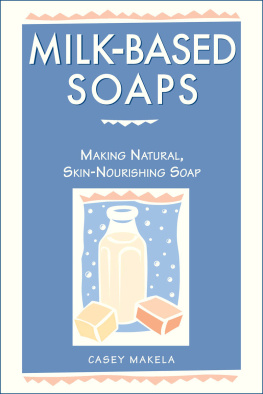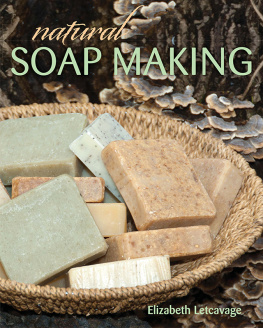Failor Catherine - Making Natural Milk Soap
Here you can read online Failor Catherine - Making Natural Milk Soap full text of the book (entire story) in english for free. Download pdf and epub, get meaning, cover and reviews about this ebook. City: NY, year: 1999;2000, publisher: Storey Publishing, LLC, genre: Home and family. Description of the work, (preface) as well as reviews are available. Best literature library LitArk.com created for fans of good reading and offers a wide selection of genres:
Romance novel
Science fiction
Adventure
Detective
Science
History
Home and family
Prose
Art
Politics
Computer
Non-fiction
Religion
Business
Children
Humor
Choose a favorite category and find really read worthwhile books. Enjoy immersion in the world of imagination, feel the emotions of the characters or learn something new for yourself, make an fascinating discovery.

- Book:Making Natural Milk Soap
- Author:
- Publisher:Storey Publishing, LLC
- Genre:
- Year:1999;2000
- City:NY
- Rating:4 / 5
- Favourites:Add to favourites
- Your mark:
- 80
- 1
- 2
- 3
- 4
- 5
Making Natural Milk Soap: summary, description and annotation
We offer to read an annotation, description, summary or preface (depends on what the author of the book "Making Natural Milk Soap" wrote himself). If you haven't found the necessary information about the book — write in the comments, we will try to find it.
Making Natural Milk Soap — read online for free the complete book (whole text) full work
Below is the text of the book, divided by pages. System saving the place of the last page read, allows you to conveniently read the book "Making Natural Milk Soap" online for free, without having to search again every time where you left off. Put a bookmark, and you can go to the page where you finished reading at any time.
Font size:
Interval:
Bookmark:
excerpted from Milk-Based Soaps by Casey Makela
Soapmaking is a blend of science and art. Once you have mastered the technique of mixing fats and alkalis to make soap, you can unleash your imagination. Learn the basics of soapmaking, then experiment with colors, shapes, scents, and textures to create one-of-a-kind handicrafts.
Soap is created when a fat is mixed with an alkali. When the two ingredients combine, a chemical reaction occurs. This reaction is known as saponification.
Soap can be made with either animal or vegetable fats. In this bulletin, vegetable fats are used, since they complement the gentle nature of milk-based soaps. The alkali used most often in home-based soapmaking is sodium hydroxide. Its commonly called caustic soda or lye. This bulletin uses the term lye.

Milk has long been revered as a cosmetic ingredient. Its an excellent moisturizer and has been heralded throughout the ages as a skin softener that even the most delicate skin types can trust. Milk makes soap richer, creamier, and less drying to the skin.
Soap is mentioned in the writings of Pliny the Elder, the first-century naturalist and historian. In 77 A.D., Pliny described various forms of hard and soft soaps that were used by women to make their hair shine. An extensive soap factory was discovered among the ruins of Pompeii, an ancient Roman resort. Despite efforts by the Christian church to discourage bathing as immodest, soap was valued as an article of commerce in early Europe.
In the 13th century, Italy introduced soapmaking to France. At that time, most soap was made by boiling goat tallow with beech-wood ash and water. French soapmakers refined the quality of soap by using olive oil instead of animal fats. Around 1500, the French introduced soap to England, where the industry grew rapidly.
In the American colonies, soapmaking was as important as spinning, weaving, candlemaking, and other common domestic skills. Fats were rendered from slaughtered livestock. Trees, especially hardwoods, were burned to create a fine ash. The ashes were kept in a leaching barrel a large wooden barrel with a plugged hole near the base.
A thin layer of stones was placed in the bottom, then the barrel was filled with straw and ashes. Leaching barrels were kept close to the house or barn where they could catch rain runoff. Once the ashes in the leaching barrel were saturated, the plug was removed and enough lye-water for a batch of soap was drained into a nonmetal container.
A common test of the lye-waters strength was to dip a feather in it. If the feather dissolved, the lye-water was strong enough to make soap. If not, the water was poured back into the leaching barrel to strengthen. The caustic lye-water could easily burn the skin and the added danger of stirring a kettle filled with hot fats over an open fire made soapmaking hazardous.
In 1621, soap ash was an important and lucrative export from America to England, providing the colonies with a much needed source of income. Settlements in what are now Maine and New Hampshire gained great wealth from soap ash and fat exports to England.
Using wood ash to produce enough alkali for soapmaking was tedious, time consuming, and labor intensive. In 1791, Nicolas Leblanc discovered a process for inexpensively manufacturing caustic soda on a large scale. Leblancs discovery revolutionized the soap industry and eliminated the need to import soap from the colonies.
The chemist M.E. Chevreul characterized the differences between fats and oils in the 1800s. His research uncovered the underlying principles of saponification. No discovery has contributed more to the basic, comprehensive understanding of soapmaking than Chevreuls.
Leblancs and Chevreuls discoveries helped to modernize the soapmaking process. By the first half of the 19th century, large-scale manufacturing operations were in place. It was common for soap to be manufactured in huge kettles containing 100,000 to 1 million pounds of liquid soap. These kettles were heated by open fires and the contents were constantly stirred until the soap was ready to be poured. Then, the mixture was hand-ladled into large wooden molds, where the saponifying soap hardened until it could be cut.
An early American soap manufacturing company was founded in 1806 by William Colgate of New York. By 1850, New England was the principal center of soap manufacturing in the United States. The introduction of perfumed and colored soaps was the beginning of the multibillion-dollar soap industry of today.
Commercial soapmaking barely resembles the simplicity of early production in either ingredients or the manufacturing process. Most store-bought soaps are laden with synthetic fillers and additives, and though they may be labeled pure, they are not necessarily wholesome.
No one knows who first added milk to soap, though milk has been used as an ingredient in cosmetics and therapeutic treatments in different cultures for thousands of years. Centuries ago, Cleopatra indulged in luxurious milk baths to preserve her legendary beauty. The soothing and moisturizing qualities of milk have made it an increasingly popular ingredient in commercial soaps, especially over the last 30 years.
Milk is rich in proteins, vitamins, and minerals. Chemically, milk is a lipoprotein: Its made up of lipids plus protein. (A lipid is an organic substance thats insoluble in water and is usually somewhat greasy to the touch.) Lipids, found in most skin creams in the form of animal or vegetable oil or wax, help seal in moisture.

Milk is unique in its natural ability to moisturize and nourish the skin. It is a fragile miracle of nature that cannot be synthetically reproduced. But its gentle properties are easily destroyed.
Milk is not a beverage; it is a food. It is the fluid secreted by the mammary glands of female mammals and is a complete food for the young of each species. Milk has a very high nutritional value for humans. It contains all the known and essential amino acids that we cannot synthesize in sufficient quantities.
When the term milk is used in North America, it is generally assumed to refer to cows milk. In other areas of the world, however, milk may mean something different. For example, in India, buffalo milk is commonly consumed. Nomadic tribes in the Middle East drink horse milk. Goats milk is very common in European and Middle Eastern countries, and milk from sheep is used to make excellent cheeses in Europe. Laplanders natives of northern Sweden, Norway, Finland, or Russia drink reindeer milk.
Animal milk has been used as a food since before recorded history. Cheese is mentioned in the Book of Job. Hindu writings dating to before 1400 B.C. refer to the use of butter as food.
Ancient Greeks, Romans, and Scythians did not use butter as food. Instead, they applied butter to skin injuries, used the soot of burned butter as an ointment for sore eyes, and considered pure butter to be an excellent hair dressing.
Font size:
Interval:
Bookmark:
Similar books «Making Natural Milk Soap»
Look at similar books to Making Natural Milk Soap. We have selected literature similar in name and meaning in the hope of providing readers with more options to find new, interesting, not yet read works.
Discussion, reviews of the book Making Natural Milk Soap and just readers' own opinions. Leave your comments, write what you think about the work, its meaning or the main characters. Specify what exactly you liked and what you didn't like, and why you think so.



